Abstract
Oral treatment of Salmonella typhimurium infection with ciprofloxacin was compared with conventional chemotherapy with ampicillin or chloramphenicol in normal (CFW1) and immunocompromised (C57BL/6) mice. Administration of the antibiotics for 12 days reduced the number of bacteria in livers and the mortality of C57BL/6 mice significantly. Ciprofloxacin was considerably more effective than ampicillin in prolongation of the mean survival time of these mice. Similar to conventional chemotherapeutic agents, ciprofloxacin did not prevent fatal disease in most C57BL/6 mice when the treatment lasted 12 days only. On the other hand, ciprofloxacin cured lethal S. typhimurium illness in immunocompromised mice after long-term oral chemotherapy for 26 days at a dosage of 100 mg/kg twice a day. This was not achieved by either ampicillin or chloramphenicol. In normal mice, 12 days of therapy with ciprofloxacin was sufficient for a significant decrease in both the number of viable bacteria in livers and the mortality of lethally infected mice. The results provide a basis for an alternative antibiotic treatment by the oral route in immunocompromised hosts with systemic infections.
Full text
PDF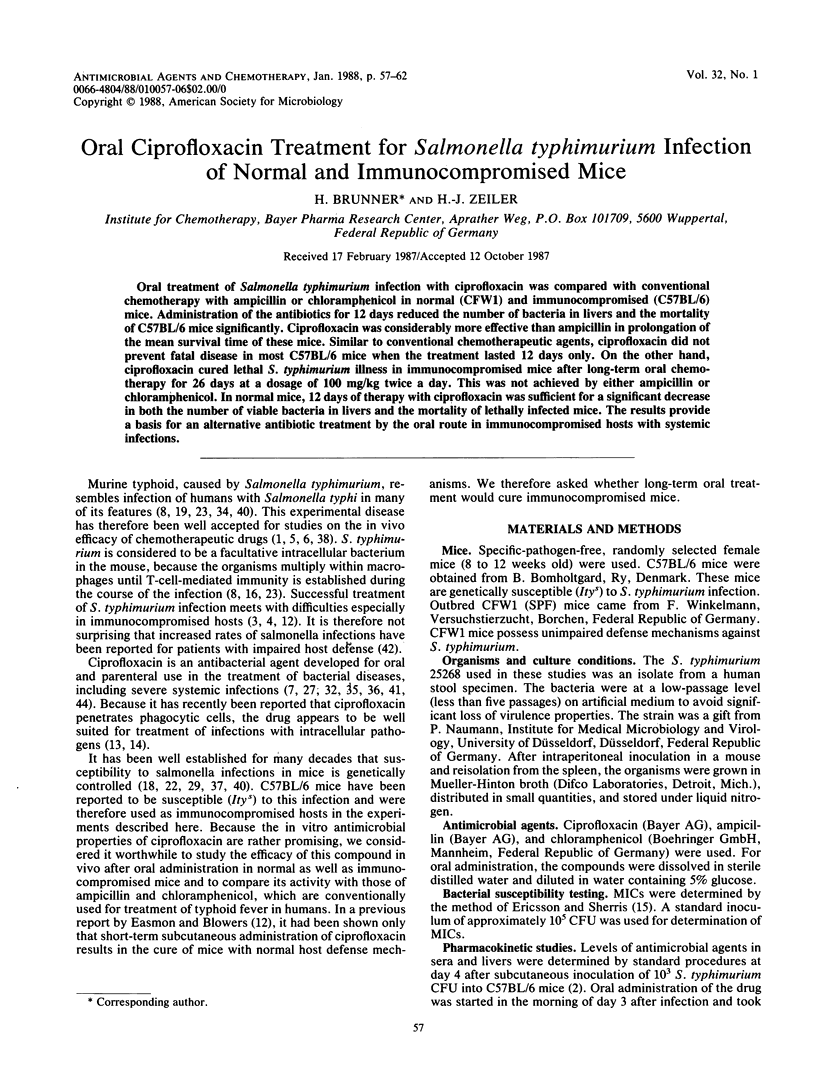
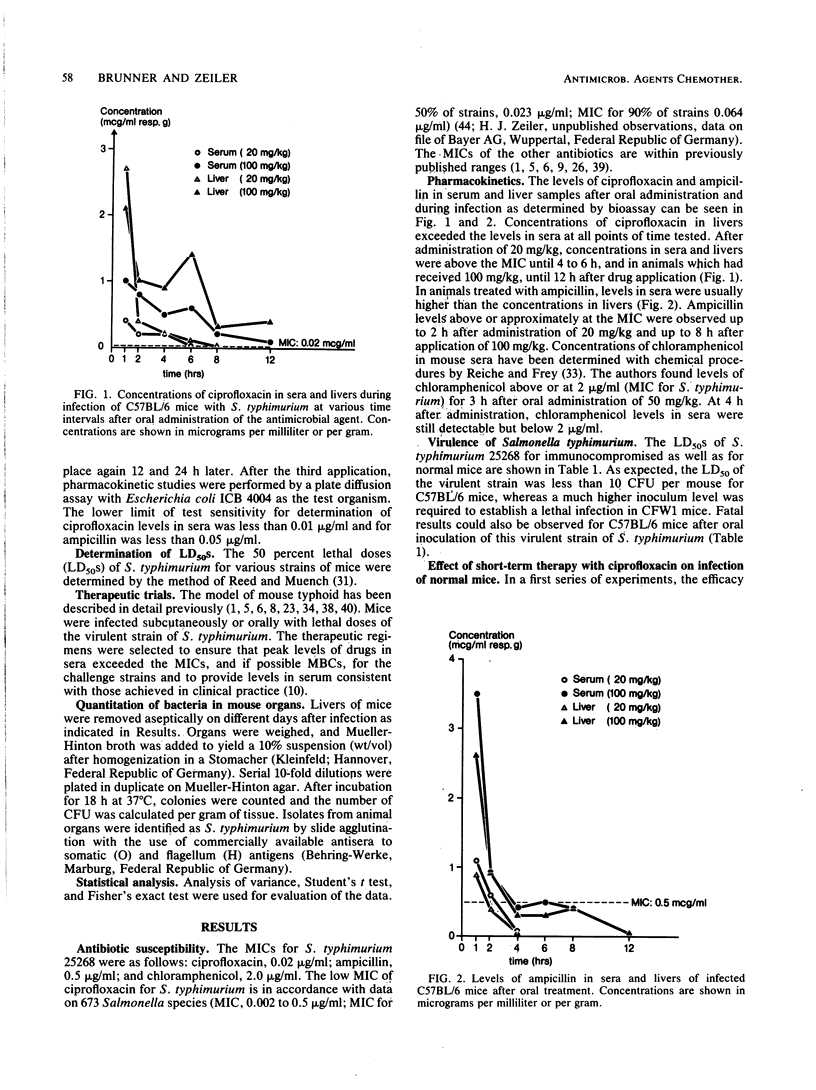
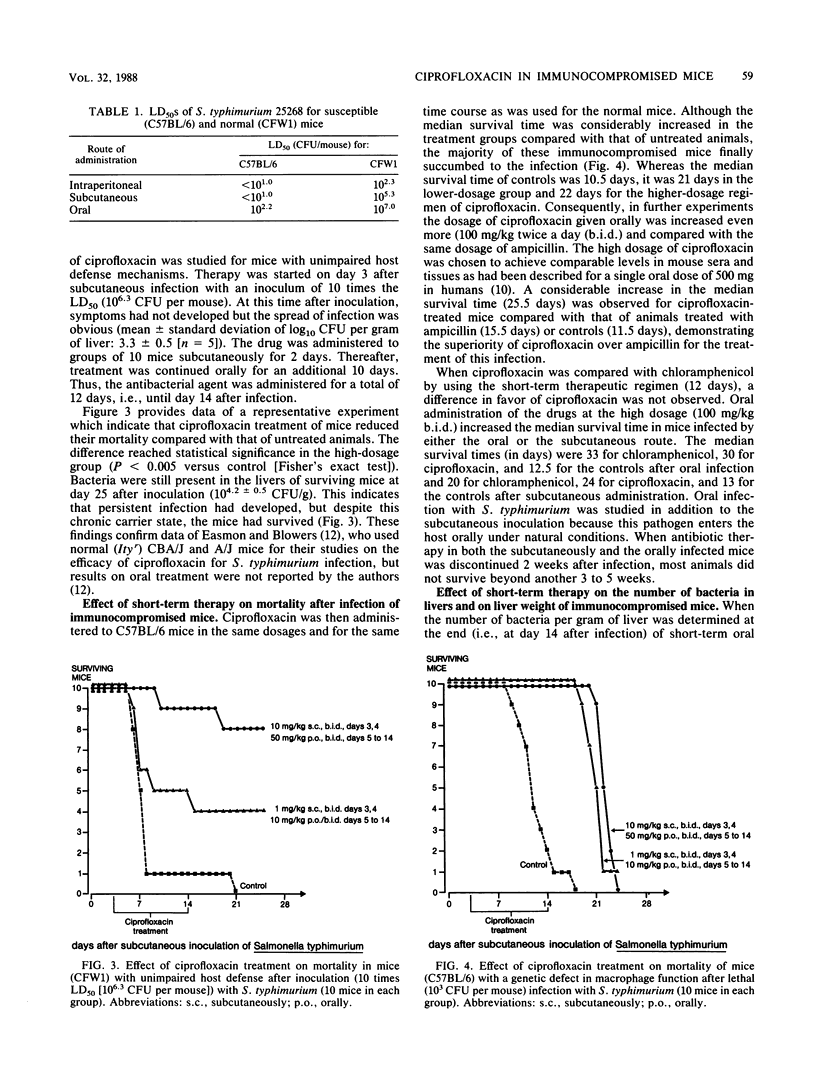
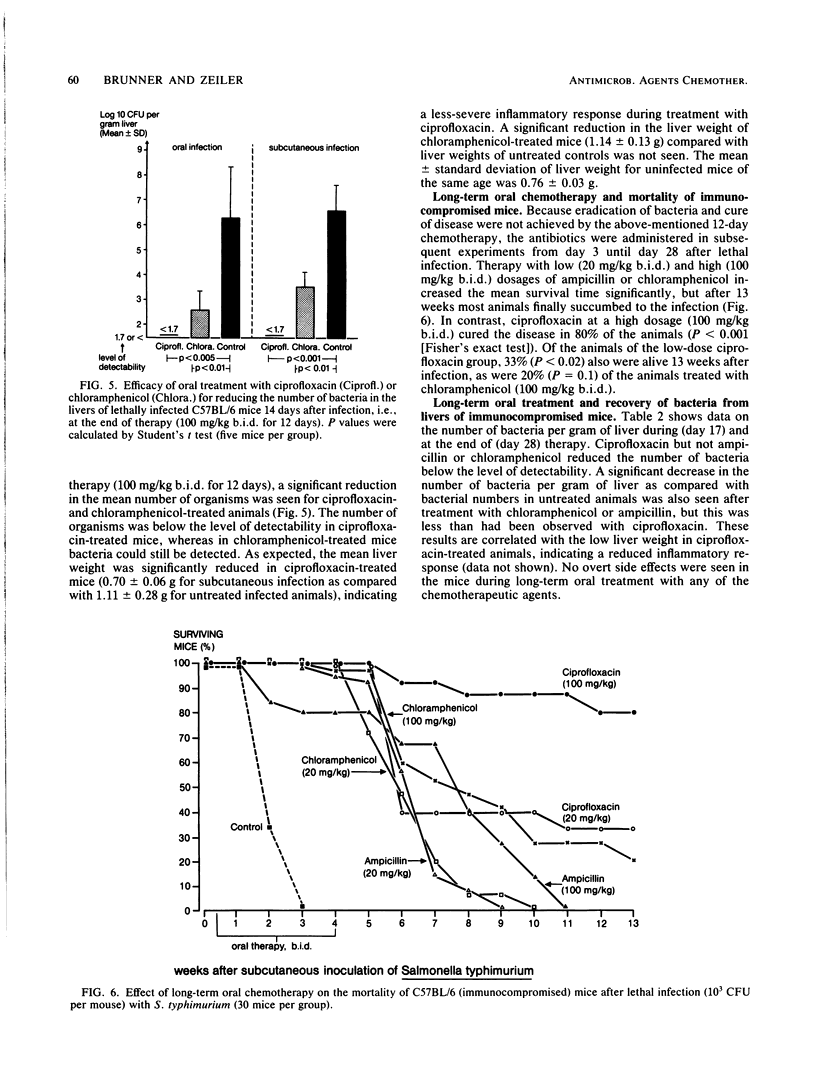
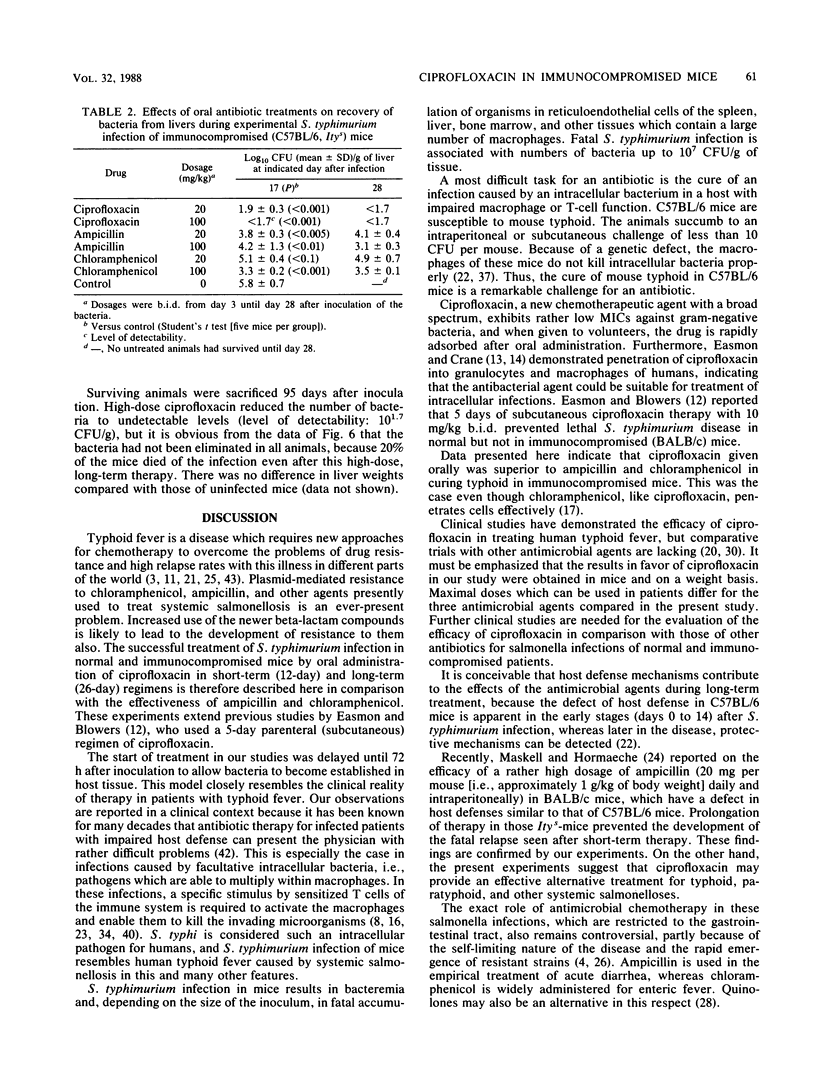
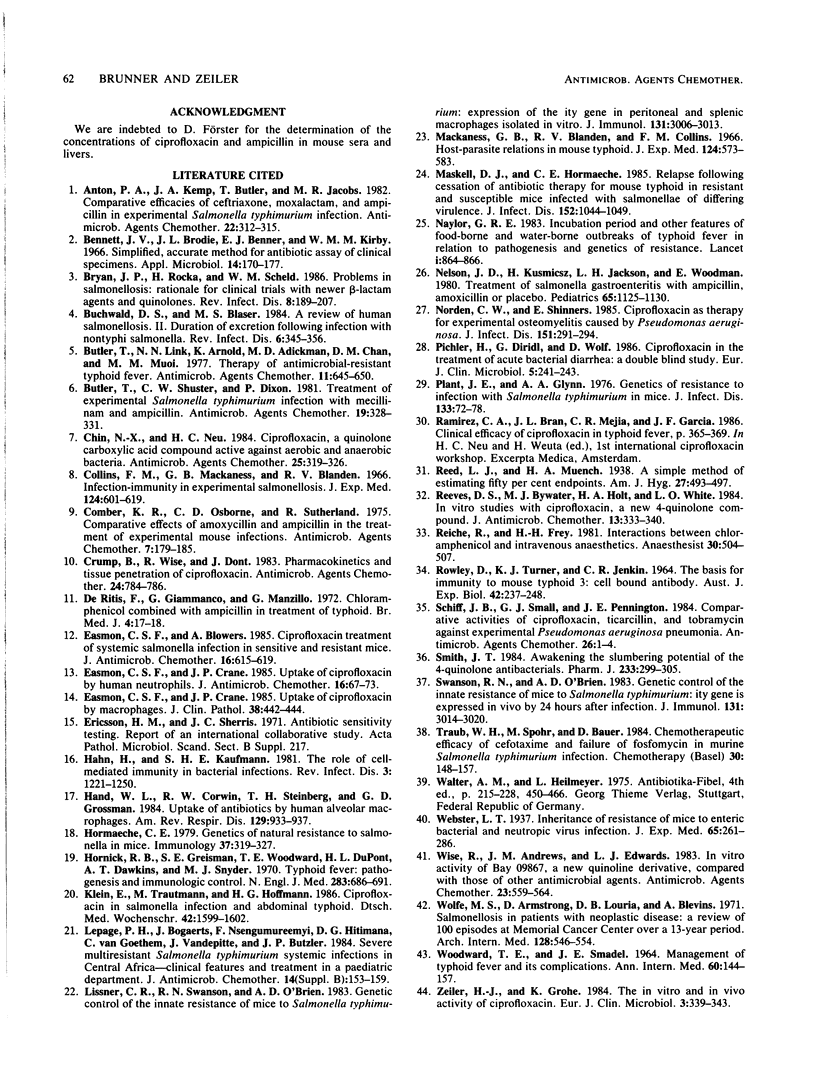
Selected References
These references are in PubMed. This may not be the complete list of references from this article.
- Anton P. A., Kemp J. A., Butler T., Jacobs M. R. Comparative efficacies of ceftriaxone, moxalactam, and ampicillin in experimental Salmonella typhimurium infection. Antimicrob Agents Chemother. 1982 Aug;22(2):312–315. doi: 10.1128/aac.22.2.312. [DOI] [PMC free article] [PubMed] [Google Scholar]
- Bennett J. V., Brodie J. L., Benner E. J., Kirby W. M. Simplified, accurate method for antibiotic assay of clinical specimens. Appl Microbiol. 1966 Mar;14(2):170–177. doi: 10.1128/am.14.2.170-177.1966. [DOI] [PMC free article] [PubMed] [Google Scholar]
- Bryan J. P., Rocha H., Scheld W. M. Problems in salmonellosis: rationale for clinical trials with newer beta-lactam agents and quinolones. Rev Infect Dis. 1986 Mar-Apr;8(2):189–207. doi: 10.1093/clinids/8.2.189. [DOI] [PubMed] [Google Scholar]
- Buchwald D. S., Blaser M. J. A review of human salmonellosis: II. Duration of excretion following infection with nontyphi Salmonella. Rev Infect Dis. 1984 May-Jun;6(3):345–356. doi: 10.1093/clinids/6.3.345. [DOI] [PubMed] [Google Scholar]
- Butler T., Linh N. N., Arnold K., Adickman M. D., Chau D. M., Muoi M. M. Therapy of antimicrobial-resistant typhoid fever. Antimicrob Agents Chemother. 1977 Apr;11(4):645–650. doi: 10.1128/aac.11.4.645. [DOI] [PMC free article] [PubMed] [Google Scholar]
- Butler T., Shuster C. W., Dixon P. Treatment of experimental Salmonella typhimurium infection with mecillinam and ampicillin. Antimicrob Agents Chemother. 1981 Feb;19(2):328–331. doi: 10.1128/aac.19.2.328. [DOI] [PMC free article] [PubMed] [Google Scholar]
- Chin N. X., Neu H. C. Ciprofloxacin, a quinolone carboxylic acid compound active against aerobic and anaerobic bacteria. Antimicrob Agents Chemother. 1984 Mar;25(3):319–326. doi: 10.1128/aac.25.3.319. [DOI] [PMC free article] [PubMed] [Google Scholar]
- Collins F. M., Mackaness G. B., Blanden R. V. Infection-immunity in experimental salmonellosis. J Exp Med. 1966 Oct 1;124(4):601–619. doi: 10.1084/jem.124.4.601. [DOI] [PMC free article] [PubMed] [Google Scholar]
- Comber K. R., Osborne C. D., Sutherland R. Comparative effects of amoxycillin and ampicillin in the treatment of experimental mouse infections. Antimicrob Agents Chemother. 1975 Feb;7(2):179–185. doi: 10.1128/aac.7.2.179. [DOI] [PMC free article] [PubMed] [Google Scholar]
- Crump B., Wise R., Dent J. Pharmacokinetics and tissue penetration of ciprofloxacin. Antimicrob Agents Chemother. 1983 Nov;24(5):784–786. doi: 10.1128/aac.24.5.784. [DOI] [PMC free article] [PubMed] [Google Scholar]
- De Ritis F., Giammanco G., Manzillo G. Chloramphenicol combined with ampicillin in treatment of typhoid. Br Med J. 1972 Oct 7;4(5831):17–18. doi: 10.1136/bmj.4.5831.17. [DOI] [PMC free article] [PubMed] [Google Scholar]
- Easmon C. S., Blowers A. Ciprofloxacin treatment of systemic salmonella infection in sensitive and resistance mice. J Antimicrob Chemother. 1985 Nov;16(5):615–619. doi: 10.1093/jac/16.5.615. [DOI] [PubMed] [Google Scholar]
- Easmon C. S., Crane J. P. Uptake of ciprofloxacin by human neutrophils. J Antimicrob Chemother. 1985 Jul;16(1):67–73. doi: 10.1093/jac/16.1.67. [DOI] [PubMed] [Google Scholar]
- Easmon C. S., Crane J. P. Uptake of ciprofloxacin by macrophages. J Clin Pathol. 1985 Apr;38(4):442–444. doi: 10.1136/jcp.38.4.442. [DOI] [PMC free article] [PubMed] [Google Scholar]
- Ericsson H. M., Sherris J. C. Antibiotic sensitivity testing. Report of an international collaborative study. Acta Pathol Microbiol Scand B Microbiol Immunol. 1971;217(Suppl):1+–1+. [PubMed] [Google Scholar]
- Hahn H., Kaufmann S. H. The role of cell-mediated immunity in bacterial infections. Rev Infect Dis. 1981 Nov-Dec;3(6):1221–1250. doi: 10.1093/clinids/3.6.1221. [DOI] [PubMed] [Google Scholar]
- Hand W. L., Corwin R. W., Steinberg T. H., Grossman G. D. Uptake of antibiotics by human alveolar macrophages. Am Rev Respir Dis. 1984 Jun;129(6):933–937. doi: 10.1164/arrd.1984.129.6.933. [DOI] [PubMed] [Google Scholar]
- Hormaeche C. E. Genetics of natural resistance to salmonellae in mice. Immunology. 1979 Jun;37(2):319–327. [PMC free article] [PubMed] [Google Scholar]
- Hornick R. B., Greisman S. E., Woodward T. E., DuPont H. L., Dawkins A. T., Snyder M. J. Typhoid fever: pathogenesis and immunologic control. N Engl J Med. 1970 Sep 24;283(13):686–691. doi: 10.1056/NEJM197009242831306. [DOI] [PubMed] [Google Scholar]
- Klein E., Trautmann M., Hoffmann H. G. Ciprofloxacin bei Salmonelleninfektion und Typhus abdominalis. Dtsch Med Wochenschr. 1986 Oct 17;111(42):1599–1602. doi: 10.1055/s-2008-1068678. [DOI] [PubMed] [Google Scholar]
- Lepage P., Bogaerts J., Nsengumuremyi F., Hitimana D. G., Van Goethem C., Vandepitte J., Butzler J. P. Severe multiresistant Salmonella typhimurium systemic infections in Central Africa--clinical features and treatment in a paediatric department. J Antimicrob Chemother. 1984 Sep;14 (Suppl B):153–159. doi: 10.1093/jac/14.suppl_b.153. [DOI] [PubMed] [Google Scholar]
- Lissner C. R., Swanson R. N., O'Brien A. D. Genetic control of the innate resistance of mice to Salmonella typhimurium: expression of the Ity gene in peritoneal and splenic macrophages isolated in vitro. J Immunol. 1983 Dec;131(6):3006–3013. [PubMed] [Google Scholar]
- Mackaness G. B., Blanden R. V., Collins F. M. Host-parasite relations in mouse typhoid. J Exp Med. 1966 Oct 1;124(4):573–583. doi: 10.1084/jem.124.4.573. [DOI] [PMC free article] [PubMed] [Google Scholar]
- Maskell D. J., Hormaeche C. E. Relapse following cessation of antibiotic therapy for mouse typhoid in resistant and susceptible mice infected with salmonellae of differing virulence. J Infect Dis. 1985 Nov;152(5):1044–1049. doi: 10.1093/infdis/152.5.1044. [DOI] [PubMed] [Google Scholar]
- Naylor G. R. Incubation period and other features of food-borne and water-borne outbreaks of typhoid fever in relation to pathogenesis and genetics of resistance. Lancet. 1983 Apr 16;1(8329):864–866. doi: 10.1016/s0140-6736(83)91395-8. [DOI] [PubMed] [Google Scholar]
- Nelson J. D., Kusmiesz H., Jackson L. H., Woodman E. Treatment of Salmonella gastroenteritis with ampicillin, amoxicillin, or placebo. Pediatrics. 1980 Jun;65(6):1125–1130. [PubMed] [Google Scholar]
- Norden C. W., Shinners E. Ciprofloxacin as therapy for experimental osteomyelitis caused by Pseudomonas aeruginosa. J Infect Dis. 1985 Feb;151(2):291–294. doi: 10.1093/infdis/151.2.291. [DOI] [PubMed] [Google Scholar]
- Pichler H., Diridl G., Wolf D. Ciprofloxacin in the treatment of acute bacterial diarrhea: a double blind study. Eur J Clin Microbiol. 1986 Apr;5(2):241–243. doi: 10.1007/BF02013998. [DOI] [PubMed] [Google Scholar]
- Plant J., Glynn A. A. Genetics of resistance to infection with Salmonella typhimurium in mice. J Infect Dis. 1976 Jan;133(1):72–78. doi: 10.1093/infdis/133.1.72. [DOI] [PubMed] [Google Scholar]
- ROWLEY D., TURNER K. J., JENKIN C. R. THE BASIS FOR IMMUNITY TO MOUSE TYPHOID. 3. CELL-BOUND ANTIBODY. Aust J Exp Biol Med Sci. 1964 Apr;42:237–248. doi: 10.1038/icb.1964.25. [DOI] [PubMed] [Google Scholar]
- Reeves D. S., Bywater M. J., Holt H. A., White L. O. In-vitro studies with ciprofloxacin, a new 4-quinolone compound. J Antimicrob Chemother. 1984 Apr;13(4):333–346. doi: 10.1093/jac/13.4.333. [DOI] [PubMed] [Google Scholar]
- Reiche R., Frey H. H. Interactions between chloramphenicol and intravenous anesthetics. Anaesthesist. 1981 Oct;30(10):504–507. [PubMed] [Google Scholar]
- Schiff J. B., Small G. J., Pennington J. E. Comparative activities of ciprofloxacin, ticarcillin, and tobramycin against experimental Pseudomonas aeruginosa pneumonia. Antimicrob Agents Chemother. 1984 Jul;26(1):1–4. doi: 10.1128/aac.26.1.1. [DOI] [PMC free article] [PubMed] [Google Scholar]
- Swanson R. N., O'Brien A. D. Genetic control of the innate resistance of mice to Salmonella typhimurium: Ity gene is expressed in vivo by 24 hours after infection. J Immunol. 1983 Dec;131(6):3014–3020. [PubMed] [Google Scholar]
- Traub W. H., Spohr M., Bauer D. Chemotherapeutic efficacy of cefotaxime and failure of fosfomycin in murine Salmonella typhimurium infection. Chemotherapy. 1984;30(3):148–157. doi: 10.1159/000238261. [DOI] [PubMed] [Google Scholar]
- WOODWARD T. E., SMADEL J. E. MANAGEMENT OF TYPHOID FEVER AND ITS COMPLICATIONS. Ann Intern Med. 1964 Jan;60:144–157. doi: 10.7326/0003-4819-60-1-144. [DOI] [PubMed] [Google Scholar]
- Wise R., Andrews J. M., Edwards L. J. In vitro activity of Bay 09867, a new quinoline derivative, compared with those of other antimicrobial agents. Antimicrob Agents Chemother. 1983 Apr;23(4):559–564. doi: 10.1128/aac.23.4.559. [DOI] [PMC free article] [PubMed] [Google Scholar]
- Wolfe M. S., Louria D. B., Armstrong D., Blevins A. Salmonellosis in patients with neoplastic disease. A review of 100 episodes at Memorial Cancer Center over a 13-year period. Arch Intern Med. 1971 Oct;128(4):546–554. doi: 10.1001/archinte.128.4.546. [DOI] [PubMed] [Google Scholar]
- Zeiler H. J., Grohe K. The in vitro and in vivo activity of ciprofloxacin. Eur J Clin Microbiol. 1984 Aug;3(4):339–343. doi: 10.1007/BF01977490. [DOI] [PubMed] [Google Scholar]


